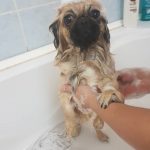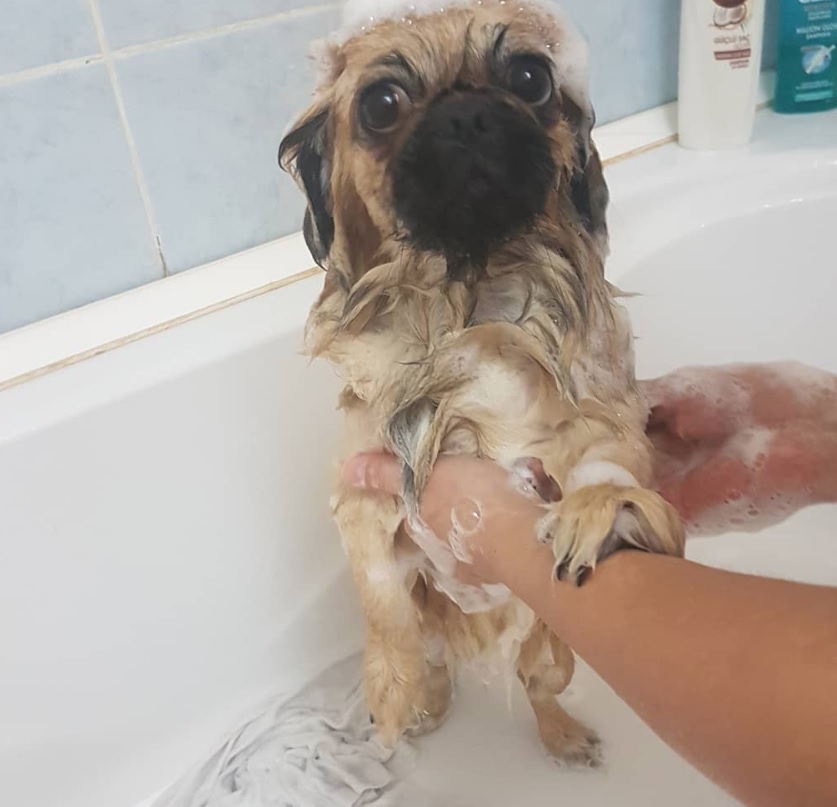The two crucial rules of bathing your Pekingese at home are: never bathe a matted coat and never bathe a shedding coat unless you have first brushed out every loose hair. Dirty and oily hair has an unpleasant smell and is more likely to mat. Frequent grooming will lessen the need for frequent bathing.
For the average well-kept Pekingese, there should be no need to bathe more than once every couple of months.
The Right Shampoo
You will get better results with a shampoo made for dogs. Dog skin has a pH of 7.5, while human skin has a pH of 5.5; thus, bathing in a shampoo formulated for the pH of human skin can lead to scaling and irritation.
Most shampoos will kill fleas even if not especially formulated as a flea shampoo, but none has any residual killing action on fleas. Therapeutic shampoos are available to aid skin problems.
Dry, scaly skin is treated with moisturizing shampoos, excessive scale and dandruff with antiseborrheic shampoos, damaged skin with antimicrobials, and itchy skin with oatmeal-based antipruritics.
Finally, all Pekingese owners should have on hand one of the shampoos that requires no water or rinsing. These are wonderful for puppies, spot baths, emergencies, and bathing when time does not permit.
Training for Bath Time
Even the most devoted of owners seldom look forward to bath time. Unfortunately, most owners train their dogs to hate baths through improper early bath training. They put off giving a bath, and when they do, they figure that by making it a thorough bath, the results will somehow last longer.
the most devoted of owners seldom look forward to bath time. Unfortunately, most owners train their dogs to hate baths through improper early bath training. They put off giving a bath, and when they do, they figure that by making it a thorough bath, the results will somehow last longer.
The secret is to give lots of tiny baths, so tiny the Pekingese puppy doesn’t have a chance to get scared. Rinse (don’t even wash) one leg today, an ear tomorrow, and so on. Be firm, soothing, and playful. A sink with a hand-held spray is most convenient.
Once you have worked up to a full-scale bath, begin with a thorough brushing to remove tangles and distribute oils, then wet your dog down, working forward from the rear. Use water that would be comfortable for you to bathe in, and be sure to keep some running on your hand in order to monitor any temperature changes.
A fractious Peke could inadvertently hit a faucet knob and cause himself to be scalded. If you keep one hand on your dog’s neck or ear, he is less likely to splatter you with a wet dog shake.
Once soaked, use your hand or a soft brush to work in the shampoo (it will go a lot further and be easier to apply if you first mix the shampoo with warm water).
Pay special attention to the oily area around the ear base, but avoid getting water in the dog’s ears (try plugging them with cotton). Rinse thoroughly, this time working from the head back. A cream rinse is optional.
Drying your Pekingese
When towel drying, be sure not to rub to the point of creating tangles. The coat will look even better if you blow it dry while brushing the hair backward. Again, you must accustom your Pekingese to a blow dryer gradually, and always keep your hand at the place on the dog you are drying. Once your hand gets uncomfortably hot, you know the dog’s skin must also be uncomfortable.
A high-velocity dryer, which dries by blowing air at high speed rather than by blowing hot air, is better. Blow in a steady direction to avoid tangling.
Learn more about coat care for Pekingese

